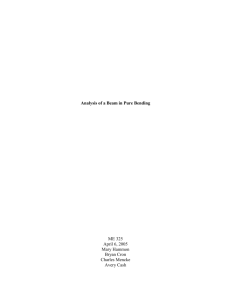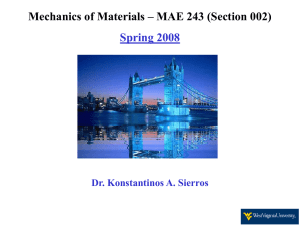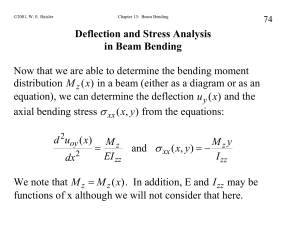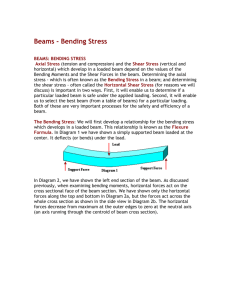Lecture 17
advertisement
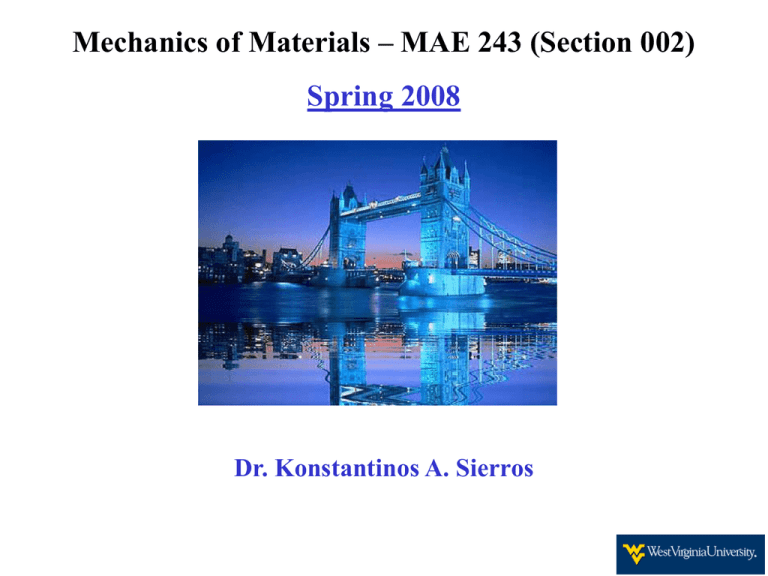
Mechanics of Materials – MAE 243 (Section 002) Spring 2008 Dr. Konstantinos A. Sierros Problem 4.3-1 Calculate the shear force V and bending moment M at a cross section just to the left of the 1600-lb load acting on the simple beam AB shown in the figure. Problem 4.3-12 A simply supported beam AB supports a trapezoidally distributed load (see figure). The intensity of the load varies linearly from 50 kN/m at support A to 30 kN/m at support B. Calculate the shear force V and bending moment M at the midpoint of the beam. Problem 4.3-14 The simply-supported beam ABCD is loaded by a weight W = 27 kN through the arrangement shown in the figure. The cable passes over a small frictionless pulley at B and is attached at E to the end of the vertical arm. Calculate the axial force N, shear force V, and bending moment M at section C, which is just to the left of the vertical arm. (Note: Disregard the widths of the beam and vertical arm and use centerline dimensions when making calculations.) 5.1: Stresses in beams - Introduction • Stresses and strains associated with shear forces and bending moments of beams • The loads acting on the beam cause it to bend. The initially straight axis (fig 5-1a) is bent into a curve which is called the deflection curve (fig 5-1b) • All loads act in the xy plane, known as the plane of bending • The deflection of the beam at any point along its axis is the displacement of that point from its original position, measured in the y direction Bending of a cantilever beam: (a) beam with load, and (b) deflection curve FIG. 5-1 Copyright 2005 by Nelson, a division of Thomson Canada Limited 5.2:Pure bending and non-uniform bending • Pure bending refers to flexure of a beam under a constant bending moment (figs 5-2 and 5-3) •Non-uniform bending refers to flexure in the presence of shear forces, which means that the bending moment changes as we move along the axis of the beam FIG. 5-4 FIG. 5-2 Simple beam in pure bending (M = M1) Copyright 2005 by Nelson, a division of Thomson Canada Limited Simple beam with central region in pure bending and end regions in nonuniform bending Copyright 2005 by Nelson, a division of Thomson Canada Limited FIG. 5-3 Cantilever beam in pure bending (M = M2) Copyright 2005 by Nelson, a division of Thomson Canada Limited 5.3: Curvature of a beam • When loads are applied to a beam, its longitudinal axis is deformed into a curve. The resulting strains and stresses in the beam are directly related to the curvature of the deflection curve • Point O’ is the center of curvature and ρ is the radius of curvature κ For small deflections FIG. 5-5 Curvature of a bent beam: (a) beam with load, and (b) deflection curve Copyright 2005 by Nelson, a division of Thomson Canada Limited 5.3: Curvature of a beam • The sign convention for curvature depends upon the orientation of the coordinate axis • Positive when the beam is bent concave upward • Negative when the beam is bent concave downward FIG. 5-6 Sign convention for curvature Copyright 2005 by Nelson, a division of Thomson Canada Limited 5.4: Longitudinal strains in beams • The longitudinal strains in a beam can be found by analyzing the curvature of the beam and the associated deformations • Cross-sections of the beam mn and pq remain plane and normal to the longitudinal axis • Surface ss is called the neutral surface of the beam. Its intersection with any cross-sectional plane is called the neutral axis of the cross section • Normal strains εx are created from planes that either lenghten or shorten FIG. 5-7 Strain-curvature relation Deformations of a beam in pure bending: (a) side view of beam, (b) cross section of beam, and (c) deformed beam Copyright 2005 by Nelson, a division of Thomson Canada Limited
